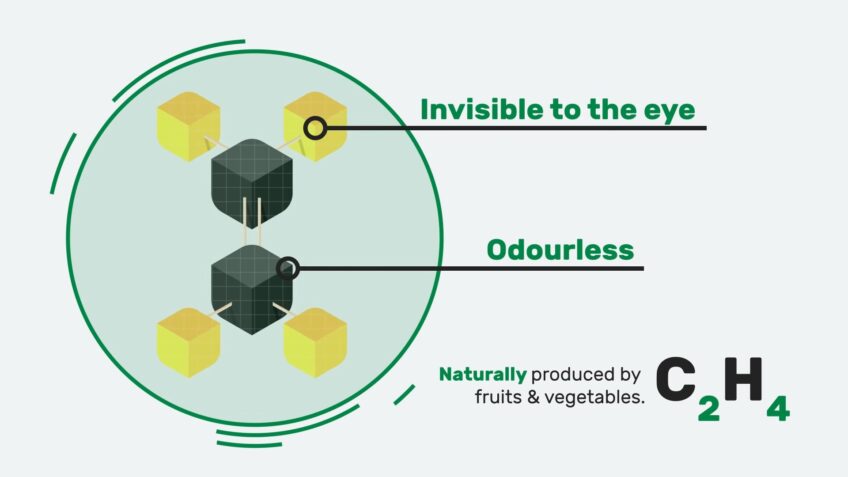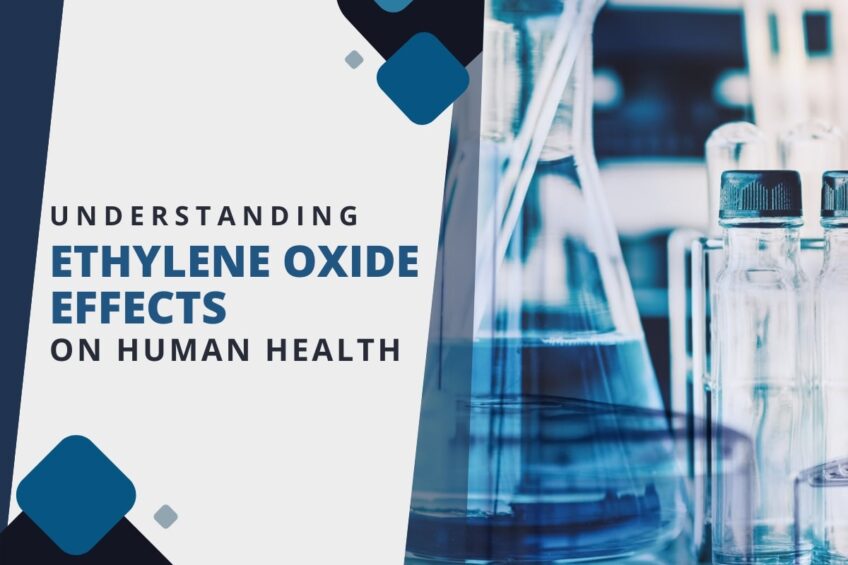What is ethylene oxide? It is a colorless, odorless gas that can be found in aerosol sprays, paints plus petroleum-based products like oil and lubricants. It is also used as an industrial fumigant and sterilization agent in medical supplies. Additionally, it is widely used by the food industry to make polyester resins and as a pesticide to control insects on fruits and vegetables.
Ethylene oxide (EtO) has numerous potential health effects on humans that have been identified in studies conducted across the world. This article will provide an overview of the potential health hazards associated with EtO exposure, as well as outline how to protect yourself from its effects. We’ll also look at some of the regulatory standards surrounding EtO use so you can make informed decisions for your safety and the safety of those around you.
What Is Ethylene Oxide?
Ethylene oxide (EtO) is a colorless, odorless gas which is an important industrial chemical used for a wide range of manufacturing processes. The chemical has been linked to various adverse health effects in humans. It is classified as a carcinogen and can cause respiratory, neurological, and other serious health problems with long-term exposure or high concentrations. In addition, EtO reacts with oxygen in the environment to form ozone-depleting substances like ethanethiol.
It has been widely used in medical device sterilization for over 50 years due to its effectiveness at killing bacteria and fungi without leaving hazardous residues or degrading the quality of processed materials. It is also widely used in food packaging, rubber manufacture, and other industrial processes. According to recent reports, more than 80 million pounds of EtO are released into the environment each year from industrial sources throughout the United States alone.
EtO vaporized into the air can be breathed in by people living or working near sources of emissions. Exposure to it can irritate eyes, nose and throat; cause respiratory symptoms like wheezing; and lead to neurological problems like headaches, dizziness, sleep disturbances and confusion. Long-term exposure may also increase risk of cancer while developing fetuses may be sensitive to its reproductive toxic effects like birth defects or miscarriages.
Sources of Ethylene Oxide

Ethylene oxide (EO) is a colorless and flammable gas known for its industrial use as a sterilizing agent for medical equipment, cosmetics, spices, and food. It is also used to make other chemical products such as antifreeze liquid soaps, detergent solvents and polyester fibers. Human exposure to ethylene oxide can occur from environmental sources such as air pollution or occupational sources like direct contact with the ethylene oxide compound.
Where Does EO Come From? The primary sources of EO come from various industries including chemical manufacturing, electronic component manufacturing, agricultural treatment facilities and industrial sites that manufacture solvent degreasing systems.
Additionally, it may be released into the environment through burning fossil fuel based transportation vehicles or through outdoor spraying of crops fertilized with ethylene oxide-containing pesticides.
What Are The Potential Health Effects? Exposure to ethylene oxide in large amounts causes irritation in eyes and lungs; prolonged exposure may even cause cancer. Long-term exposure to lower concentrations of EO may result in headache, dizziness, nausea and elevated levels of white blood cells in humans. Occupational exposure to this chemical is known to be associated with an increased risk of leukemia and lymphoma cancers; however further studies are needed to clarify this effect on humans.
Health Effects of Ethylene Oxide
Ethylene oxide is a gas used in the manufacture of several everyday products. Exposure to this chemical can lead to a variety of health problems in humans, ranging from mild eye and throat irritation to cancer.
Did you know that we encounter cancer-causing chemicals almost every day? Our investigation of L’Oréal products revealed the use of chemicals linked to cancer in its eye makeup.
In this article, we’ll discuss the potential health effects of ethylene oxide exposure, including long-term effects of repeated exposure.
Short-term Exposure
Short-term exposure to ethylene oxide can cause health effects, including skin and eye irritation, headache, nausea, and respiratory issues such as coughing or difficulty breathing. The severity of the symptoms depends on the concentration and duration of exposure. Long-term exposure may result in an increased risk of cancer due to potential mutagenic or carcinogenic characteristics.
When ethylene oxide gas is inhaled, it can quickly pass through the moist surfaces of the lungs and enter into the bloodstream. From there, it is distributed throughout the body in minutes and can accumulate at persistent levels in some organs.
The nervous system is particularly vulnerable due to its high permeability to this gas. Unprotected inhalation of high concentrations (such as those found in industrial processes) for short periods of time can become a serious health hazard. At high levels of exposure, dizziness, weakness, and confusion may occur; even loss of consciousness has been reported.
Long-term Exposure
Long-term exposure to ethylene oxide can have serious effects on human health. Chronic exposure, meaning exposure over a long period of time, can increase the risk of cancer and other illnesses. Studies show that workers exposed to high levels of ethylene oxide in the workplace had an increased risk of lymphatic and hematopoietic cancers.
In addition, occupational studies suggest that long-term ethylene oxide exposure may lead to adverse reproductive outcomes, such as early-term miscarriages and stillbirths. Animal studies also suggest that prolonged exposure to ethylene oxide can damage the nerve tissue in the brain and spinal cord as well as cause birth defects.
Long-term exposures to low concentrations of ethylene oxide may also contribute to adverse neurobehavioral effects such as changes in coordination and slower reflex responses.
Regulations and Standards

Ethylene oxide is a cancer-causing air pollutant that contributes to smog and air quality degradation. To protect human health and the environment, the United States Environmental Protection Agency (EPA) has set national standards for ethylene oxide emissions.
The EPA’s National Air Quality Standards limit concentrations of ethylene oxide in ambient (outdoor) air to 0.11 parts per billion averaged over any one hour and 12 parts per billion averaged over any 24 hours.
In addition, the EPA regulates stationary sources of ethylene oxide emissions through technology-based standards for new sources and non-binding guidelines for existing major sources under its Clean Air Act Programs.
The U.S. Occupational Safety and Health Administration (OSHA) has also established safe levels of exposure to ethylene oxide in workplace settings, limiting on-the-job exposure to 1 part per million for an 8-hour work shift seven days a week, 1 part per million for a 15 minute work period only once every three hours, and 5 parts per million as an absolute ceiling value not to be exceeded at any time during a work shift no matter how brief the exposure period may be.
Prevention and protection measures
Prevention and protection measures are essential to minimize the harmful effects of ethylene oxide exposure on human health. The following are some measures that can be taken to prevent and protect against ethylene oxide exposure:
- Proper ventilation: It is essential to ensure proper ventilation in areas where ethylene oxide is used or stored. Adequate ventilation helps to reduce the concentration of the gas in the air, thus reducing the risk of exposure.
- Personal protective equipment: Employees working with ethylene oxide should use personal protective equipment such as gloves, goggles, and respiratory protection. These protective measures help to prevent skin and eye irritation, as well as inhalation of the gas.
- Monitoring: Regular monitoring of the work environment is necessary to detect any leaks or releases of ethylene oxide. Monitoring helps to identify potential hazards and take preventive measures before any harm occurs.
- Training: Employees working with ethylene oxide should receive training on its safe handling, use, and storage. Proper training helps to increase awareness of the potential risks and the necessary precautions.
- Storage: It should be stored in a well-ventilated area away from heat sources and oxidizing agents. The storage area should be secured to prevent unauthorized access and leakage.
Overall, prevention and protection measures are crucial in minimizing the harmful effects of ethylene oxide exposure on human health. These measures, coupled with regular monitoring, training, and safe storage, can help to create a safer work environment and reduce the risk of health complications associated with ethylene oxide exposure.
FAQs

1. What foods contain ethylene oxide?
Ethylene oxide is not intentionally added to food, but it can be present in small amounts as a result of fumigation or sterilization processes. Some foods that may contain ethylene oxide include spices, cocoa powder, and certain types of nuts.
2. Why is ethylene oxide used in food?
It is used in food processing facilities to sterilize equipment and kill bacteria, viruses, and other microorganisms that can cause foodborne illnesses. It is also used as a fumigant to prevent spoilage during storage and transportation.
3. What household products is ethylene oxide in?
It is commonly used in the manufacturing of a variety of household products, including certain types of plastics, synthetic fibers, and personal care items like cosmetics and shampoos. It is also used in medical supplies, such as bandages, surgical instruments, and catheters. It’s important to find safe cosmetics that suit your skin type.
4. Do onions give off ethylene gas?
Yes, onions, along with other fruits and vegetables, naturally give off ethylene gas as they ripen. Ethylene gas is a plant hormone that promotes ripening and can also cause premature spoilage if not properly controlled.
5. Can ethylene oxide be absorbed through the skin?
Yes, it can be absorbed through the skin and can cause skin irritation, chemical burns, and other adverse effects. It is important to take proper precautions when handling products that contain ethylene oxide, such as wearing gloves and protective clothing.
Conclusion
Ethylene oxide is a dangerous chemical that can have serious impacts on the health of those exposed. Long-term exposure to ethylene oxide can cause cancer, birth defects and other health problems. It is important for those who are exposed to ethylene oxide to be aware of the risks and take steps to protect themselves from further exposure.
The best way for people to avoid exposure to ethylene oxide is to avoid airborne concentrations of the chemical, either at home or in the workplace. People should also take extra precautions when handling chemicals that contain ethylene oxide and use protective gear such as gloves and facemasks in order to reduce their risk of exposure.
Additionally, medical monitoring of exposed people should be performed on a regular basis in order to detect any health effects due to long-term exposure.

